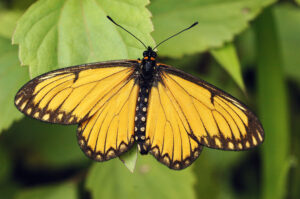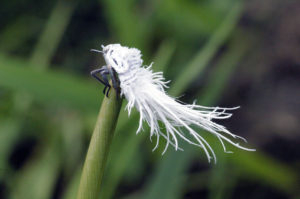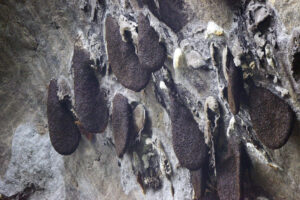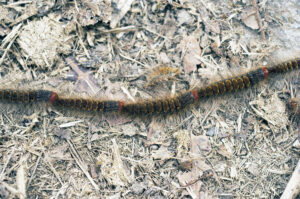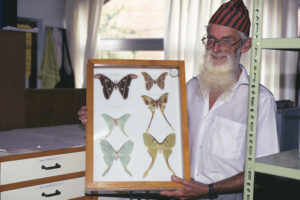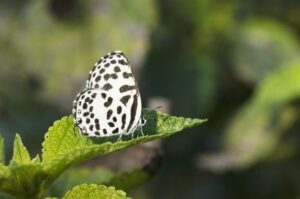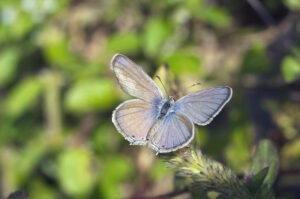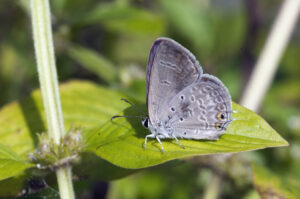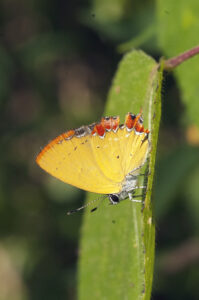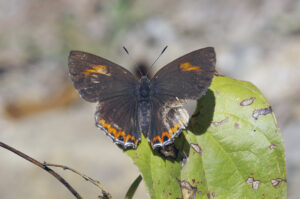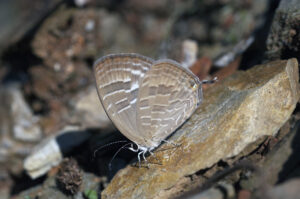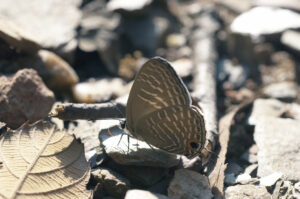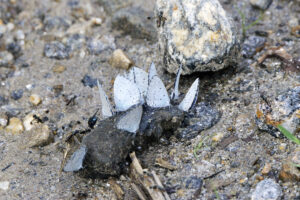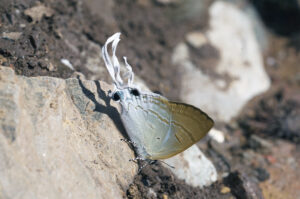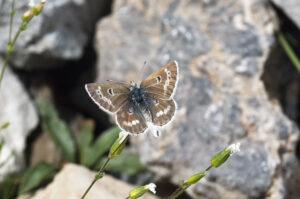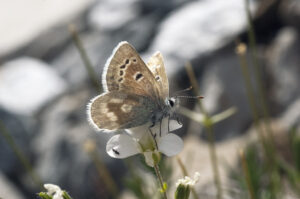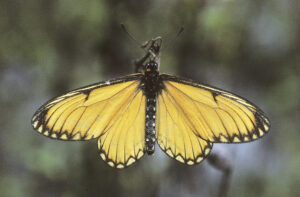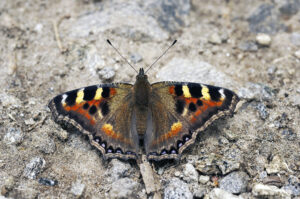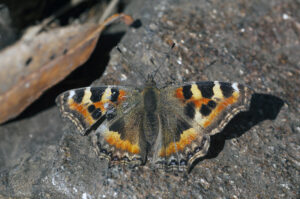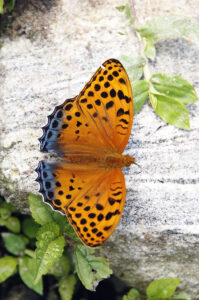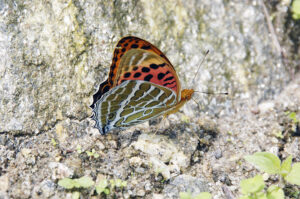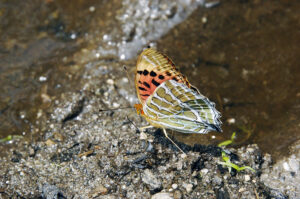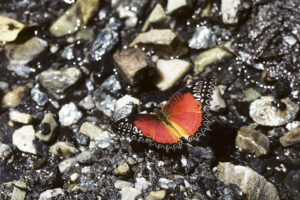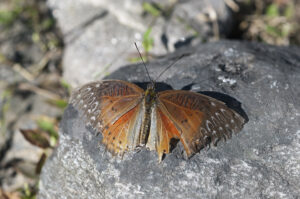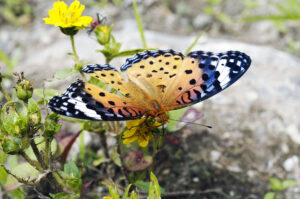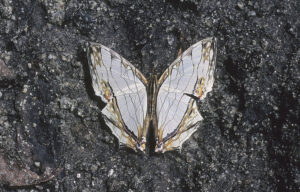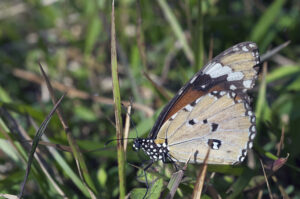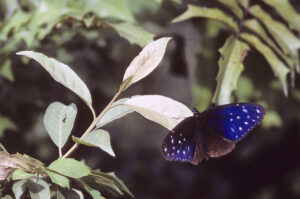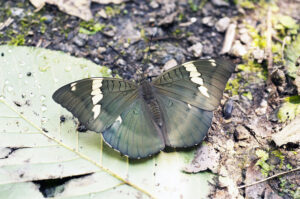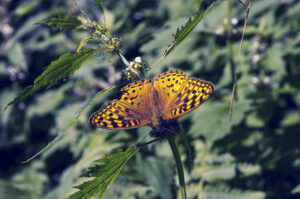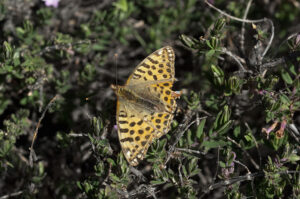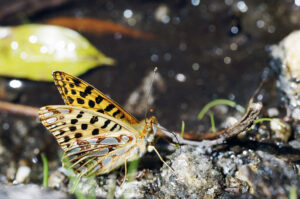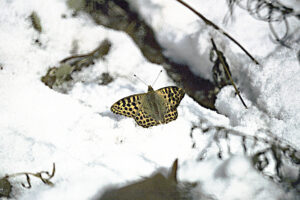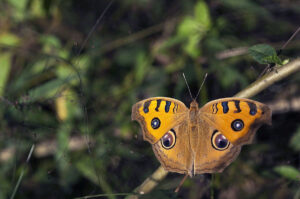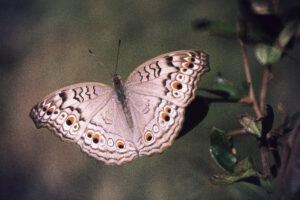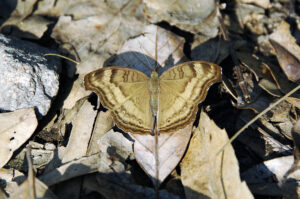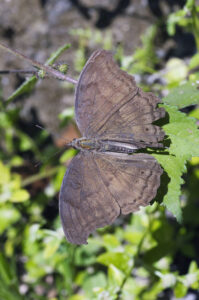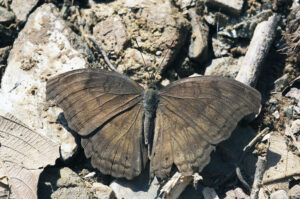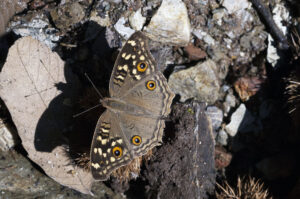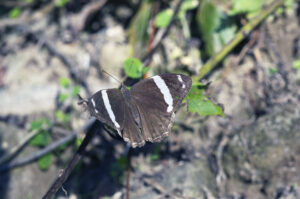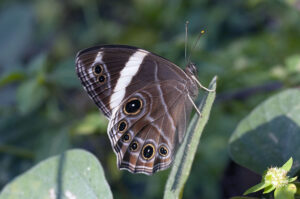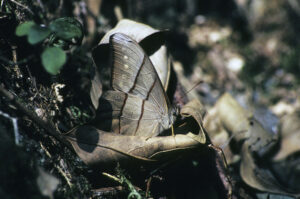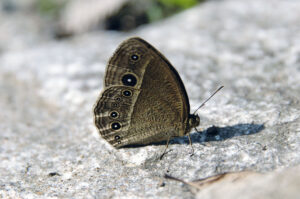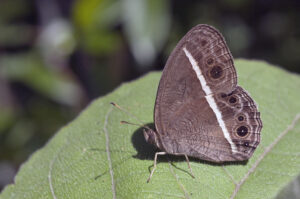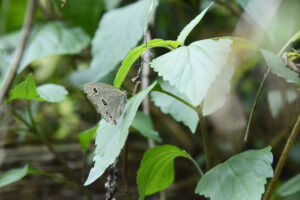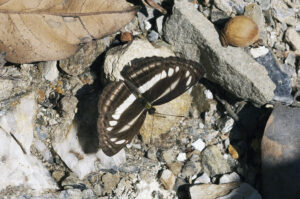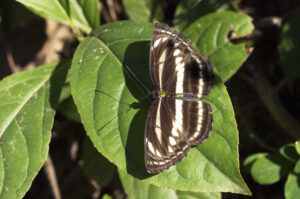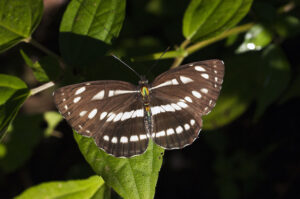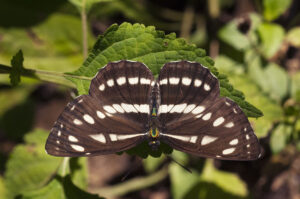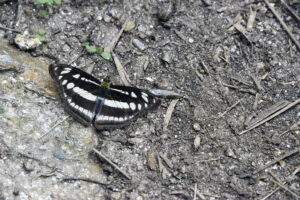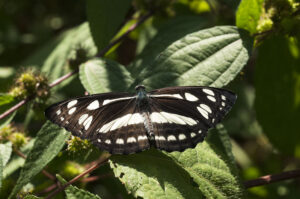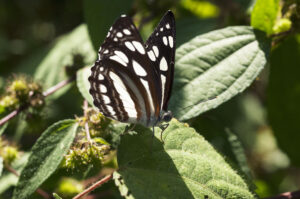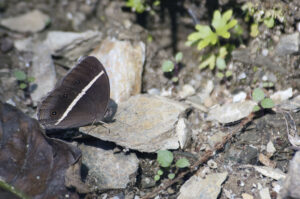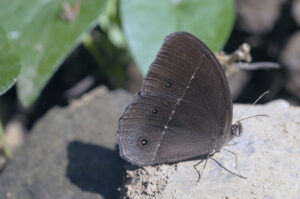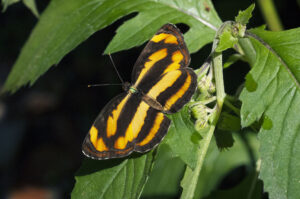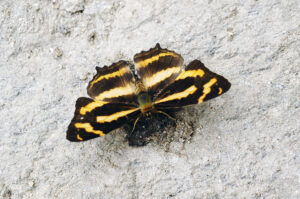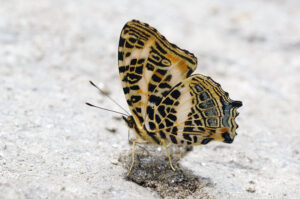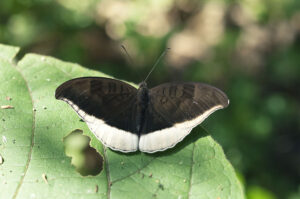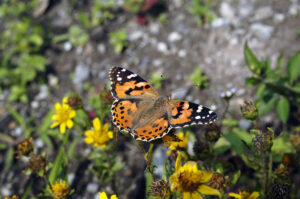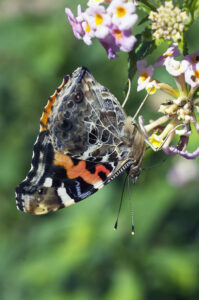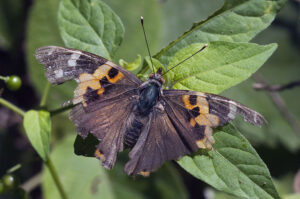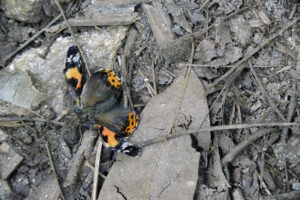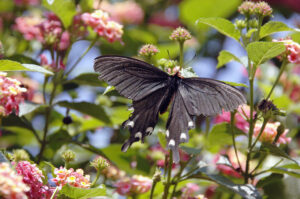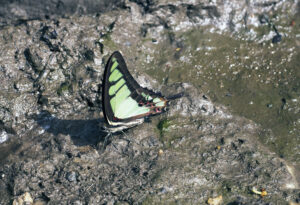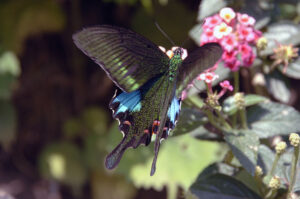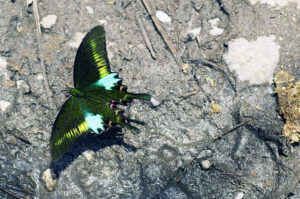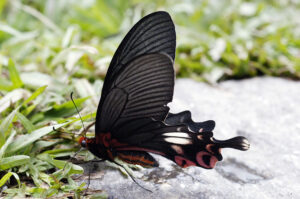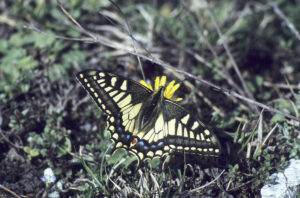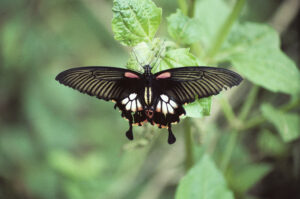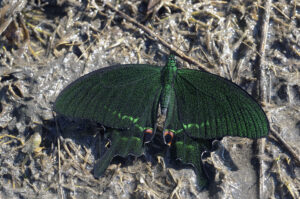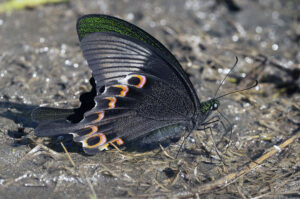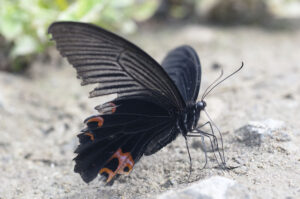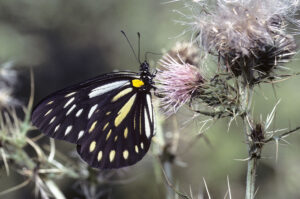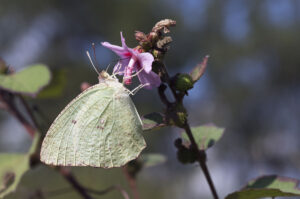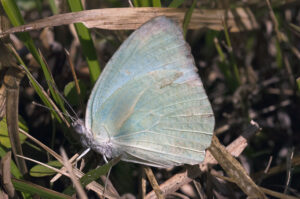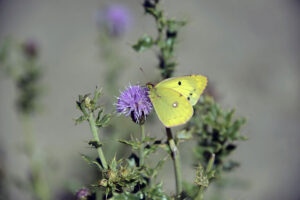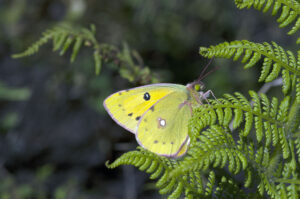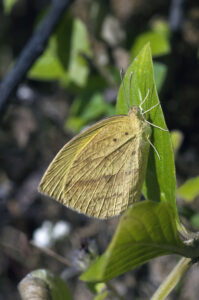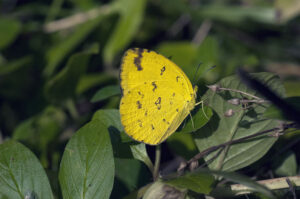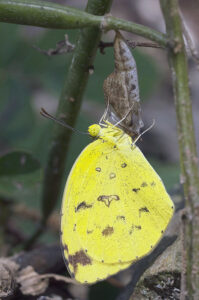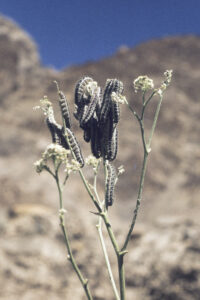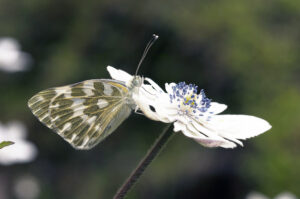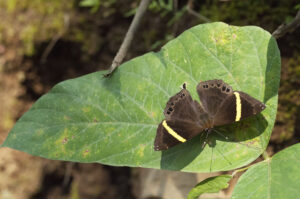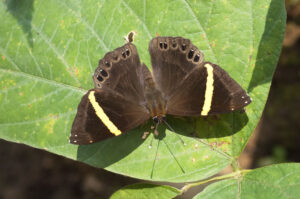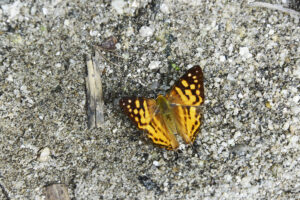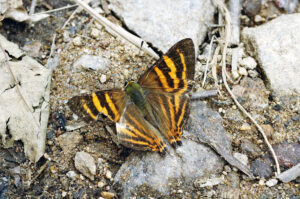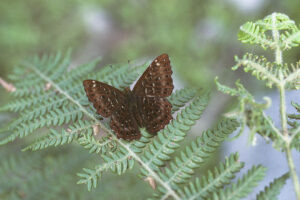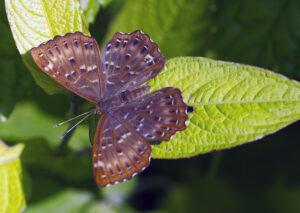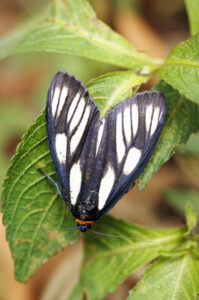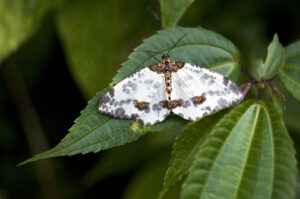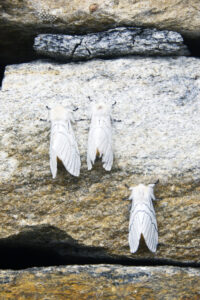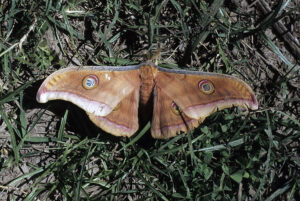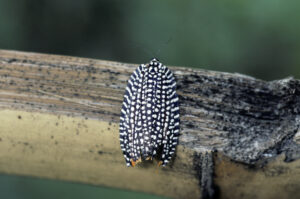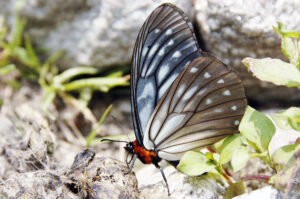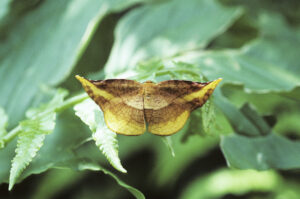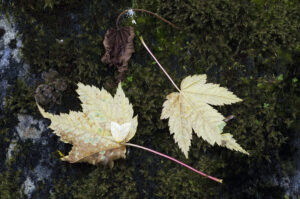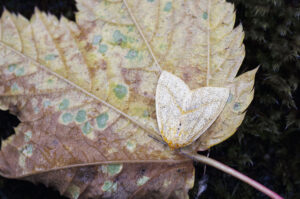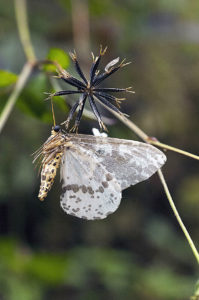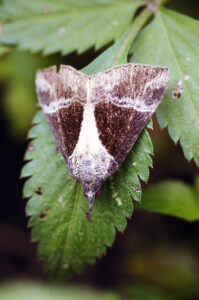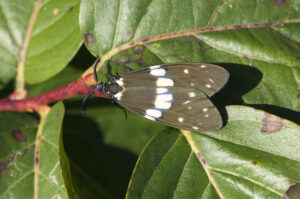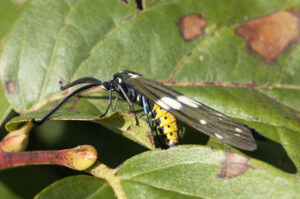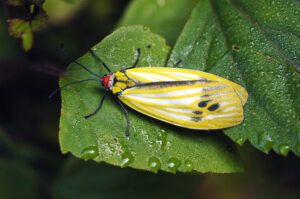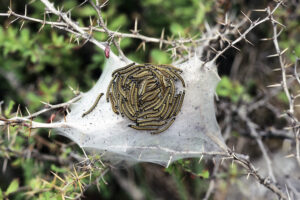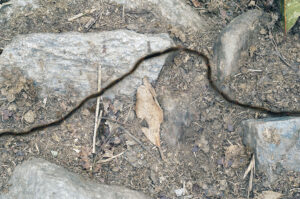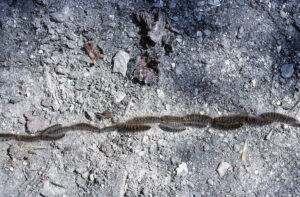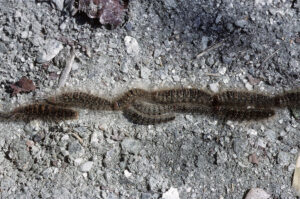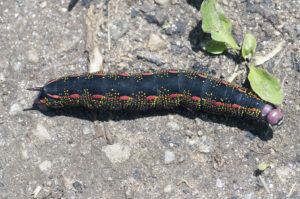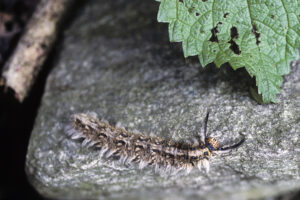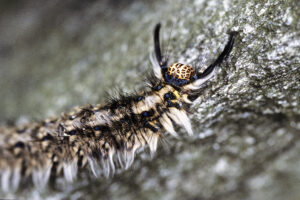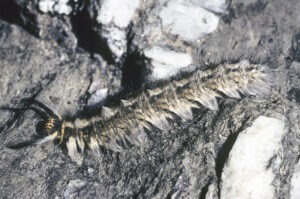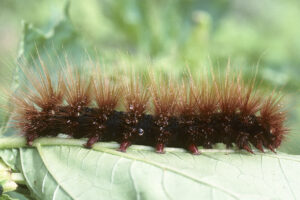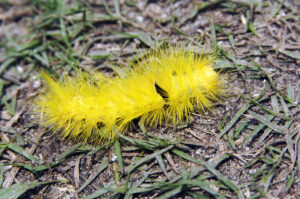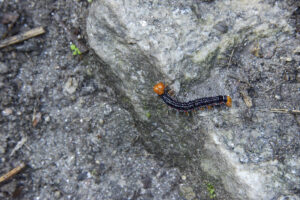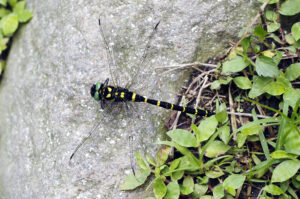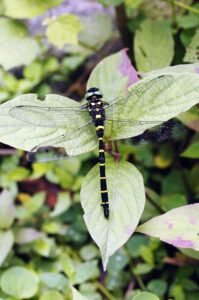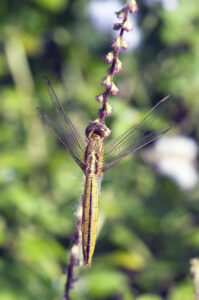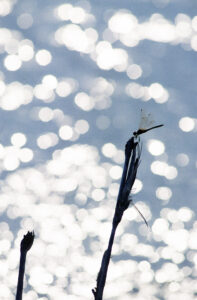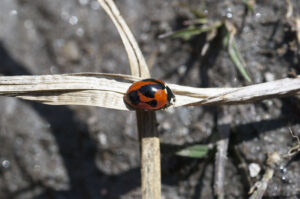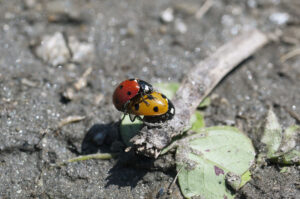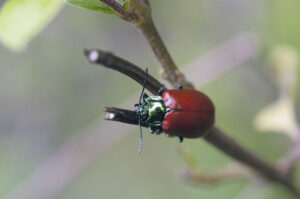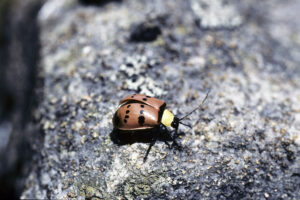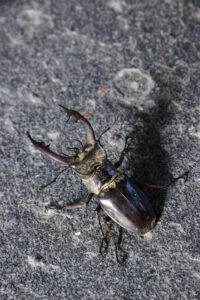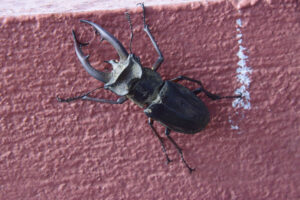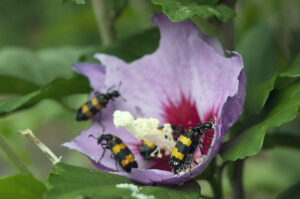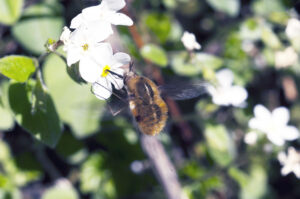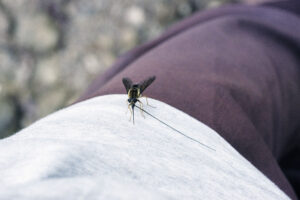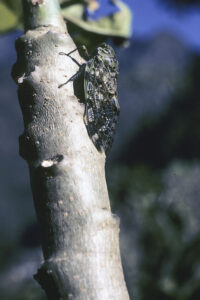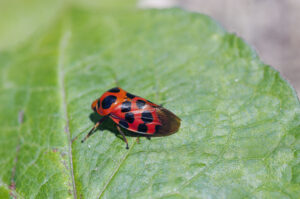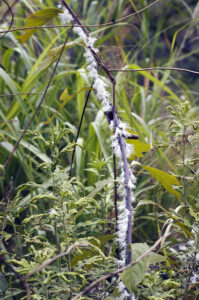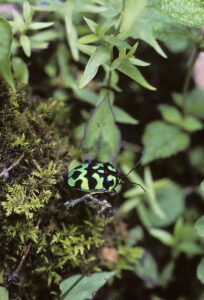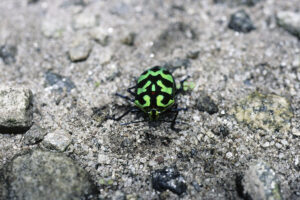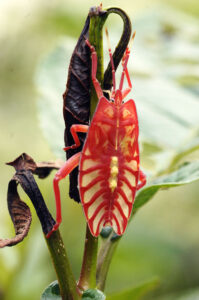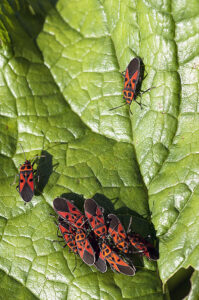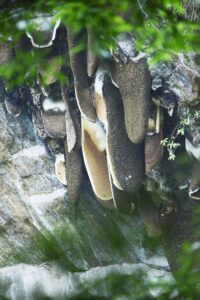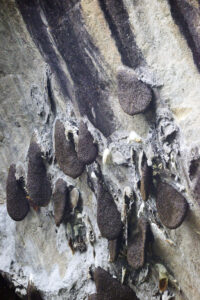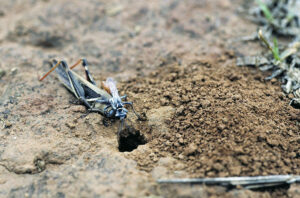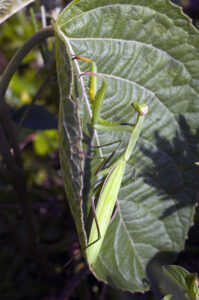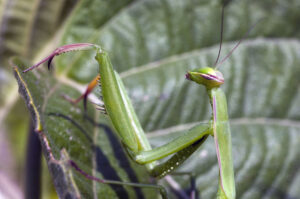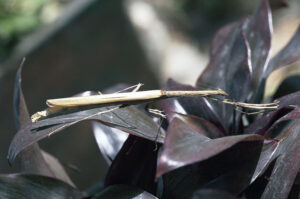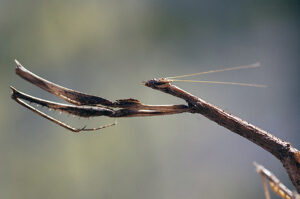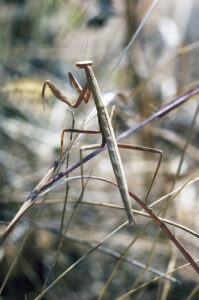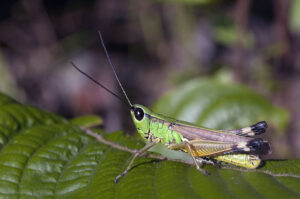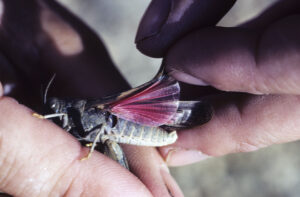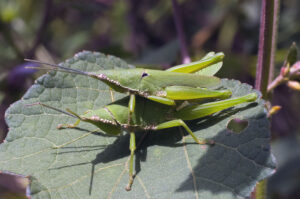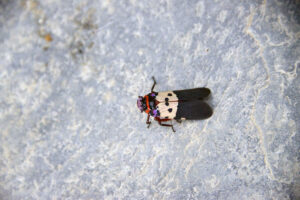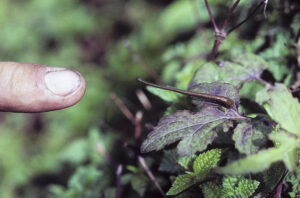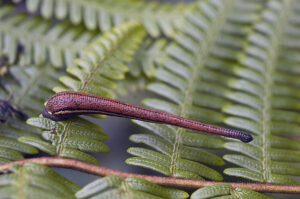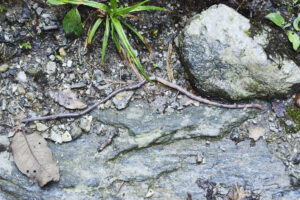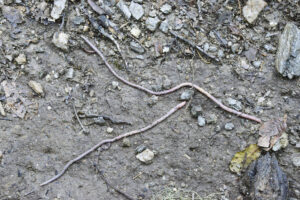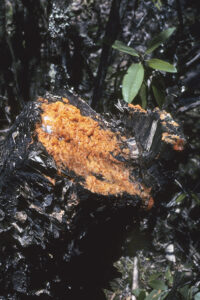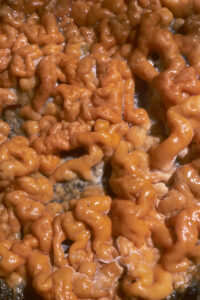Invertebrates in the Himalaya
The pretty yellow coster (Acraea issoria) is a common and widespread butterfly. This one was observed near Sinuwa, Tamur Valley, eastern Nepal. (Photo copyright © by Kaj Halberg)
This strange creature is a nymph of Phromnia marginella, a planthopper of the family Flatidae. Nymphs of this genus secrete a white, fluffy substance, which causes their enemies not to eat them. – Mitlung, Tamur Valley, eastern Nepal. (Photo copyright © by Kaj Halberg)
Nests of Himalayan honey bee, between Pairo and Bamboo, Lower Langtang Valley, central Nepal. (Photo copyright © by Kaj Halberg)
Processionary caterpillars of the family Thaumetopoeidae, Hille, Annapurna, central Nepal. (Photo copyright © by Kaj Halberg)
This page deals with a selection of Himalayan animals, which I have encountered during my travels. They are divided into sections on butterflies and moths, other insects, mollusks, and slime mold. Within each group, orders, families, genera, and species are presented in alphabetical order.
A number of pictures, depicting unidentified species, are also shown here. If you are able to identify any of these animals, or if you find any errors, I would be grateful to receive an email. You may use the address at the bottom of this page.
The word Himalaya is from the Sanskrit hima (‘snow’) and alaya (‘abode’), thus ‘The Abode of Snow’. The Himalaya consists of a long arch of gigantic mountains, stretching from northern Pakistan southeast to the northern tip of Myanmar – a distance of more than 2,500 km. In these mountains are the Earth’s largest concentration of very high peaks, fourteen of which reach an altitude of more than 8,000 m, whereas hundreds are more than 7,000 m high. (For comparison, the highest mountain outside Central Asia, Aconcagua in Argentina, is a mere 6,962 m.)
The borders of the Himalaya are not well defined. To the northwest, the Karakoram Mountains (which some authorities consider a part of the Himalaya, others do not) merge into the Hindu Kush and Pamir Mountains. To the north and northeast, several mountain chains in Ladakh, Tibet, and China are a continuation of the Himalaya proper.
As a result of the great span in altitude and precipitation – besides various other factors such as micro-climate and soil composition – flora and fauna of the Himalaya are indeed diverse. In these mountains, two bio-geographical regions meet. In most areas, flora and fauna from the Indo-Malayan Region, which includes the Indian Subcontinent and Southeast Asia, dominate, but in northern Pakistan, Kashmir, Ladakh, and in areas of far northern Nepal and Bhutan at altitudes above c. 3,500 m, there is a large element of species from the Palaearctic Region, which includes Central and West Asia.
When the monsoon has passed over the Himalaya from the south, almost all its humidity has already fallen as rain. Thus, the Tibetan Plateau north of the mountains receives very little rainfall. In many places, the annual mean precipitation is less than 100 mm, most of which falls as snow in the winter. For this reason, the major part of the landscape is dry and rather barren, with lush and green areas mainly found along rivers and around the numerous lakes of the region.
On this page, Tibet (called Xizang by the Chinese), Qinghai, and Xinjiang are treated as separate areas. The term ‘western China’ indicates Chinese territories just east of Tibet and Qinghai. The term ‘south-western China’ encompasses the provinces Yunnan, Guizhou, and Sichuan.
Lepidoptera Butterflies and moths
About 126 families and 180,000 species of this order have been described. The name means ‘scaly wing’, derived from Ancient Greek lepis (‘scale’) and pteron (‘wing’).
Contrary to the popular belief that butterflies and moths are two separate groups, genetic research has shown that butterflies are simply relatively recently derived, colourful, day-flying moths, comprising the superfamilies Hesperioidea (skippers) and Papilionoidea, the latter consisting of the families Lycaenidae (gossamer-winged butterflies, blues, coppers), Nymphalidae (brush-footed butterflies), Papilionidae (swallowtails and birdwings), Pieridae (whites, sulphers, and orange-tips), and Riodinidae (metalmark butterflies).
Today, some scientists include skippers (as the family Hesperiidae) in Papilionoidea, and also the neotropical family Hedylidae.
Moths are an immensely diverse group, making up the vast majority of the order, including all members that are not true butterflies. It is thought that there may be about 160,000 species in the group, most of which are nocturnal, but there are also crepuscular and diurnal species.
Below, the pictures are divided into 3 categories: true butterflies (day-flying, colourful species), moths, and caterpillars.
British entomologist Colin Smith (born 1936) has been living in Nepal since 1964. He is the country’s lepidoptera expert and has made huge collections of butterflies and moths. This picture was taken in Kathmandu, 2002. (Photo copyright © by Kaj Halberg)
True butterflies
It is generally believed that the word butterfly is a Medieval word, derived from ‘butter-coloured fly’, referring to the yellow male of the Brimstone butterfly (Gonepteryx rhamni).
In this section, I have gathered much information from the websites learnaboutbutterflies.com, and ftp.funet.fi/index/Tree_of_life/insecta/lepidoptera.
Lycaenidae Gossamer-winged butterflies, blues, coppers
Many members of this family are popularly called blues, as the upper wings of numerous species are various shades of blue. In the Himalaya, there is a bewildering array of species, especially in the lower parts.
Castalius Pierrots
Today, this genus contains only 4 members. A number of African species, which were formerly placed here, have been transferred to the genera Tuxentius and Zintha.
Presumably, the name pierrot refers to the predominantly white colour of these butterflies. Pierrot is a sad clown figure, originally from Asia Minor, who got a renaissance around 1500 in the Italian Commedia dell’arte. He is always dressed in white, and his face is also painted white.
Castalius rosimon Common pierrot
This species is distributed from the Indian Subcontinent eastwards to Indochina, and thence southwards to Indonesia.
Male Castalius rosimon, Pokhara, Nepal. (Photo copyright © by Kaj Halberg)
Catochrysops Forget-me-not blues
A genus of 7 species, found from the Indian Subcontinent eastwards to Indochina, and thence southwards to Indonesia, the Philippines, New Guinea, and nearby islands.
Catochrysops strabo Common forget-me-not blue
Distributed from Sri Lanka and India eastwards to Indochina and thence southwards to Indonesia and the Philippines.
This species was described as early as 1793 by Johan Christian Fabricius (1745-1808), a Danish zoologist, who had specialized in Insecta, which, in those days, included all arthropods. He was a student of the famous Swedish naturalist Carl Linnaeus, and is regarded as one of the most important entomologists of the 18th Century. He named nearly 10,000 species, and established the basis for the modern insect classification. (Source: S. L. Tuxen 1967. The entomologist J.C. Fabricius. Annual Review of Entomology 12: 1-15)
Male Catochrysops strabo, upperside and underside, Sarangkot, Pokhara, Nepal. (Photos copyright © by Kaj Halberg)
Heliophorus
This genus contains about 23 species, widely distributed in Asia.
Heliophorus epicles Purple sapphire
Divided into 6 subspecies, this gorgeous butterfly is widely distributed, from India eastwards to southern China, and thence southwards through Southeast Asia to Sumatra. In the Himalaya, it may be found up to an elevation of about 2,100 m. It mainly lives in dense forest.
Underside of Heliophorus epicles ssp. latilimbata, Pokhara, Nepal. (Photo copyright © by Kaj Halberg)
Worn female Heliophorus epicles ssp. latilimbata, Pokhara, Nepal. The ‘tails’ on its hindwings have vanished. (Photo copyright © by Kaj Halberg)
Nacaduba Line-blues
This genus contains about 50 species, widely distributed in warmer parts of Asia. The popular name stems from the numerous stripes on the underwings.
Nacaduba pactolus Large four-line blue
This species is found in the major part of Tropical Asia, from the Indian Subcontinent eastwards to southern China and Taiwan, and thence southwards to Indonesia, the Philippines, New Guinea, and nearby islands.
Nacaduba pactolus ssp. continentalis, Pokhara, Nepal. (Photos copyright © by Kaj Halberg)
Tajuria
A genus with about 35 species, found in warmer areas of the Indian Subcontinent, southern China, Taiwan, Indochina, the Philippines, and Indonesia.
Tajuria illurgis White royal
This butterfly is distributed from Himachal Pradesh eastwards along the Himalaya to northern Thailand and the Yunnan Province, with a disjunct population in Taiwan.
Several Tajuria illurgis and flies, sucking on a carnivore scat, between Surkhe and Shyabrubesi, Lower Langtang Valley, central Nepal. (Photo copyright © by Kaj Halberg)
Zeltus amasa Fluffy tit
Each of the hindwings of this butterfly, the only member of the genus, has two white, fluffy appendices, one long and the other shorter. They probably serve as a means to confuse predators. Birds tend to snap at these appendices instead of the body of the butterfly, which in this way has a greater chance of escaping.
It is distributed from the Indian Subcontinent eastwards to Southeast Asia, the Philippines, and Indonesia.
Male Zeltus amasa, drinking from soil, Pokhara, Nepal. (Photo copyright © by Kaj Halberg)
A unidentified species of blue, feeding in a flower of Minuartia kashmirica, Honupatta, Ladakh. (Photos copyright © by Kaj Halberg)
Nymphalidae Brush-footed butterflies
Comprising more than 6,000 species, this is the largest butterfly family, distributed on all continents, except Antarctica. Today, this family includes a number of subfamilies, which were previously treated as separate families, including Heliconiinae, Danainae, and Satyrinae.
The name brush-footed butterflies refers to a brush-like set of hairs on the forelegs of a number of species. Another common name is four-footed butterflies, as many members are known to stand on only four legs. The forelegs are reduced and often curled up.
Acraea
A large genus of the subfamily Heliconiinae, comprising about 150 species, most of which occur in warmer regions of Africa, with a few in the Indian Subcontinent, Southeast Asia, and Australia.
In Ancient Greek mythology, Acraea was the daughter of the river-god Asterion. Together with her sisters Euboea and Prosymna, she acted as nurse to goddess Hera.
Acraea issoria Yellow coster
A common species, found from India eastwards to the southern half of China and Taiwan, and thence southwards through Southeast Asia to Indonesia.
Male Acraea issoria, Yamphudin, Kabeli Valley, eastern Nepal. (Photo copyright © by Kaj Halberg)
Aglais Tortoiseshells
A small genus, comprising 7 species, found in temperate and subarctic areas of the Northern Hemisphere. Some authorities maintain that they should be included in the genus Nymphalis.
The name tortoiseshell usually applies to a pet, for example a cat, rabbit, or guinea-pig, whose fur is pied, with black, brown and yellow markings. Some members of the genera Aglais and Nymphalis have these colours on their wings.
Aglais caschmirensis Indian tortoiseshell
Widely distributed in Central Asia, from Tajikistan and Uzbekistan eastwards to western China, southwards to Afghanistan and the Himalaya, where it occurs from Pakistan eastwards to Sikkim. It has a very wide altitudinal distribution, found at elevations between 600 and 5,500 m.
Aglais caschmirensis, Sinuwa, Modi Khola Valley, Annapurna, central Nepal. (Photo copyright © by Kaj Halberg)
Aglais caschmirensis, Kuldi Ghar, Modi Khola Valley, Annapurna, central Nepal. A bit of the left forewing is missing, presumably snapped off by a bird. (Photo copyright © by Kaj Halberg)
Argynnis Fritillary, silverstripe
10 species of large and beautiful butterflies, 9 of which are distributed in temperate and subtropical Eurasia, and a single species, A. hyperbius, found in Tropical Asia, Australia, and East Africa.
The generic name refers to the Ancient Greek mythology. Argynnus was a beautiful boy, who was loved by the hero Agamemnon. The boy drowned in the Cephisus River, and Agamemnon erected a temple in his honour. Later, this temple was associated with Aphrodite, the goddess of love and beauty.
Argynnis childreni Himalayan fritillary, large silverstripe
This species is found in montane areas, from Nepal eastwards to China. It may readily be identified by its orange-brown hindwings, which are slaty-blue, with black dots, along the margin.
Argynnis childreni, sucking water from rocks and sand, near Tapethok, Tamur Valley, eastern Nepal. (Photos copyright © by Kaj Halberg)
Cethosia
A genus of the subfamily Heliconiinae, comprising about 10-15 species, found in the Indian Subcontinent, Southeast Asia, and Australia.
Cethosia biblis Red lacewing
This striking species is found from the Indian Subcontinent eastwards to southern China, and thence southwards to Indonesia and the Philippines. The male is bright red on the upperside, a warning signal to enemies that it has a bad taste, acquired in the larval stage from poisonous food plants.
Male Cethosia biblis ssp. tisamena, sucking moisture from a stream, near Tolka, Modi Khola Valley, Annapurna, central Nepal. (Photo copyright © by Kaj Halberg)
This very worn male Cethosia biblis ssp. tisamena, has survived several attacks from birds, which have bitten bits off its wings. – Tal, Marsyangdi Valley, Annapurna, central Nepal. (Photo copyright © by Kaj Halberg)
Cethosia cyane Leopard lacewing
Distributed from the Indian Subcontinent eastwards to the Yunnan Province, south-western China, and in Indochina, southwards to Singapore.
Cethosia cyane, feeding in flowers of Guizotia abyssinica, Tapethok, Tamur Valley, eastern Nepal. (Photo copyright © by Kaj Halberg)
Cyrestis Map butterflies
Comprising about 20 species, these butterflies are found in warmer areas of Africa, and from the Indian Subcontinent eastwards Indochina, and thence southwards to Indonesia and New Guinea. The common name stems from the wing pattern of some species, which resemble the lines of latitude and longitude on a map, including the species below.
Cyrestis thyodamas Common map
This striking species is found in the Indian Subcontinent and Indochina.
Cyrestis thyodamas, sucking moisture from sand, Dana, Kali Gandaki Valley, Annapurna, central Nepal. (Photo copyright © by Kaj Halberg)
Danaus Monarchs, tigers
These butterflies, comprising 11 species, are members of the subfamily Danainae, which was previously regarded as a separate family, Danaidae. They are found on all continents, except Europe and Antarctica.
The generic name has a peculiar background. Originally, the American monarch (D. plexippus) was described in 1758 by Swedish naturalist Carl Linnaeus (1707-1778) in his Systema Naturae, where he placed it in the genus Papilio – the only genus of butterflies in those days.
In Ancient Greek mythology, Danaus was a king in northern Africa, who founded the city of Argos in Peloponnes. Linnaeus made a note, saying that the names of members of the Danai festivi, the division of the genus to which Papilio plexippus belonged, were derived from the names of males in the classical Greek mythology. Danai festivi formed one division, containing colourful species, as opposed to the other division, Danai candidi, which contained species with bright white wings, whose members were named after names of females in the Greek mythology.
Danaus chrysippus Plain tiger, African monarch
A very widespread butterfly, found in Asia, Australia, and Africa. It is quite common in the lower parts of the Himalaya.
The specific name was applied by Linnaeus. It refers to Chrysippus, one of the sons of Aegyptus, twin brother of Danaus (see above).
Danaus chrysippus, Pokhara, Nepal. (Photo copyright © by Kaj Halberg)
Euploea Crows
A genus of about 60 species, distributed in warmer parts of Asia, New Guinea, and Australia, with a few species on islands in the Indian Ocean.
The common name was applied due to many of the species being rather dark, often blackish, on the upperside. Like other members of the subfamily Danainae, they are poisonous due to feeding on toxic plants in the larval stage. The caterpillars are often strongly coloured as a warning sign to predators.
Euploea midamus Blue-spotted crow
This species is found from Uttarakhand eastwards to southern China, and thence southwards through Southeast Asia and the Philippines to Indonesia. As with other members of the genus, the caterpillars are poisonous due to feeding on toxic members of the dogbane family (Apocynaceae). Initially, they are green and inconspicuous, but later they become orange-yellow with several long, curved, black appendices, thus announcing to enemies that they are ill-tasting.
Euploea midamus, Yamphudin, Kabeli Valley, eastern Nepal. (Photo copyright © by Kaj Halberg)
Euthalia Barons, counts, dukes
This genus contains about 63 species, native to East and Tropical Asia, with the highest concentration in China. Many species are splendid, a fact reflected in their common names.
Euthalia patala Grand duchess
This gorgeous species occurs from Himachal Pradesh eastwards to central China, and thence southwards to Indochina. Feeding plants of the caterpillars in the Himalaya include banj oak (Quercus leucotrichophora). (Source: R.N. Mathur & B. Singh 1959. A list of insect pests of forest plants in India and adjacent countries. Indian Forest Bulletin 171 (7): 1-130)
Euthalia patala, Neuli, Sainj Valley, Himachal Pradesh. (Photo copyright © by Kaj Halberg)
Fabriciana Fritillary
This widespread genus, comprising 11 species, is found from western Europe and North Africa eastwards through the entire Siberia to the Pacific coast, and thence southwards to the Himalaya and southern China.
Initially, these butterflies were placed in the genus Argynnis (above), but were moved to a separate genus in 1922 by German entomologist and herpetologist Albert Franz Theodor Reuss (1879-1958), in honour of Danish zoologist Johan Christian Fabricius (see Catochrysops strabo above).
Fabriciana kamala
This species is restricted to temperate areas of the north-western Himalaya, from northern Pakistan eastwards to Uttarakhand, and adjacent areas of Tibet.
Fabriciana kamala, feeding in flowers of motherwort (Leonurus cardiaca), Rolla, Great Himalayan National Park, Himachal Pradesh. (Photo copyright © by Kaj Halberg)
Issoria Queen fritillaries
This genus contains about 12 species, with 6 species in the Neotropics, 4 in south-eastern Africa, and 2 in Europe, North Africa, and temperate areas of Asia.
Issoria isaea Spangled queen fritillary, Himalayan queen fritillary
This species is found in montane areas, from the western Himalaya eastwards to the Yunnan Province of China. Previously, it was considered a subspecies of the widespread Queen of Spain fritillary (I. lathonia), and some authorities still regard it as such. However, the latter, which is found across Europe, North Africa, and the Middle East, is strongly migratory, whereas the Himalayan queen fritillary is sedentary.
Issoria isaea, sitting in a species of honeysuckle, Lonicera rupicola, Dusum, Khumbu, Nepal. (Photo copyright © by Kaj Halberg)
Issoria isaea, sucking moist from the ground, Khanjim, Langtang National Park, Nepal. (Photo copyright © by Kaj Halberg)
Issoria isaea is a hardy species. This one is sitting on newly fallen snow, Nanda Devi National Park, Uttarakhand. (Photo copyright © by Kaj Halberg)
Junonia Pansy, buckeye, commodore
This genus, comprising about 33 species, is found on all continents except Antarctica. It was established in 1819 by German entomologist Jacob Hübner (1761-1826), who was one of the first to study butterflies in depth. He described many new genera and species and was the author of Sammlung Europäischer Schmetterlinge (‘Collection of European Butterflies’), published 1796-1805.
In Roman mythology, the goddess Juno was the protector and special counsellor of the state. She was the daughter of Saturn, the wife of Jupiter, and the mother of Mars, Vulcan, Bellona, and Juventas. Her Ancient Greek counterpart is Hera.
Previously, many of the species were placed in the genus Precis.
Junonia almana Peacock pansy
A very common species, living in a wide variety of habitats. It is distributed from India and Sri Lanka eastwards to southern China, Southeast Asia, the Philippines, and Indonesia. In the Himalaya, it is mostly found below an elevation of 500 m, but may occasionally be encountered up to 1,000 m.
Junonia almana, Pokhara, Nepal. (Photo copyright © by Kaj Halberg)
Junonia atlites Grey pansy
A common and widespread species in southern Asia, from Kashmir eastwards to southern China, southwards to Sri Lanka, Indonesia, and the Philippines. In the Himalaya, it is mainly encountered at low altitudes.
Junonia atlites, Sauraha, southern Nepal. (Photo copyright © by Kaj Halberg)
Junonia iphita Chocolate pansy
The upperside of the wings of this species vary from pale to dark brown. It is distributed from the Indian Subcontinent eastwards to southern China, and thence southwards to Java. These butterflies are rather territorial, often basking in the sun in forest glades.
Junonia iphita, pale form, near Sekathum, Tamur Valley, eastern Nepal. (Photo copyright © by Kaj Halberg)
Junonia iphita, dark form, Pokhara, Nepal. (Photos copyright © by Kaj Halberg)
Junonia lemonias Lemon pansy
This common species is distributed from the Indian Subcontinent eastwards to central China, and thence southwards to Indochina.
Junonia lemonias, Pokhara, Nepal. (Photo copyright © by Kaj Halberg)
Lethe Treebrowns
This genus, comprising about 112 species, was formerly placed in the family Satyridae. These butterflies are mainly distributed in temperate forests of Asia, although some species are found in Tropical Asia. Several species are very local, being confined to one mountain or mountain chain. Most species have earth-brown upperwings. The underwing is usually more strongly marked than the upperwing, the hindwing having 7 prominent ocelli (‘eyes’).
Lethe confusa Banded treebrown
This species may readily be identified by a clear white diagonal band on the forewing and the large ocelli. It occurs from Nepal eastwards to northern Indochina, and thence southwards to Sulawesi and Java. In the Himalaya, it may be encountered up to an elevation of about 1,000 m. Foodplants of the caterpillar includes various bamboo species.
Lethe confusa, Sarangkot, Pokhara, Nepal. (Photo copyright © by Kaj Halberg)
Lethe confusa, Pokhara, Nepal. (Photo copyright © by Kaj Halberg)
Lethe kansa Bamboo forester
Found from Uttarakhand eastwards to northern Indochina and southern parts of the Yunnan Province of China. The underside of the wings are pale brown with two dark brown streaks on forewing as well as hindwing, whereas the ocelli are rather faint.
Lethe kansa, Mure, Arun Valley, eastern Nepal. (Photo copyright © by Kaj Halberg)
Mycalesis Bushbrowns
This genus, which is confined to the Oriental and Australian regions, was formerly included in the family Satyridae. It is one of the largest genera in Satyrinae, comprising about 88 species.
These butterflies are all various shades of brown on both wing surfaces, marked with a series of conspicuous ocelli (‘eyes’), and a straight whitish line across the underside of both wings. Many of the species are very similar.
Mycalesis francisca Lilacine bushbrown
This highly variable species, divided into 6 or 7 subspecies, is distributed from Uttarakhand eastwards to Indochina, China, Taiwan, and Japan. The common name stems from the line across the wings having a lilac sheen in some subspecies. The line and ocelli are very faint in the dry-season form.
Mycalesis francisca, between Sekathum and Tapethok, Tamur Valley, eastern Nepal. (Photo copyright © by Kaj Halberg)
Mycalesis malsara White-line bushbrown
This species occurs from the north-western Himalaya eastwards to Indochina and the Yunnan Province of China.
Mycalesis malsara, Pokhara, Nepal. (Photo copyright © by Kaj Halberg)
Mycalesis perseus Common bushbrown
This common butterfly is found from the Indian Subcontinent eastwards to Taiwan, and thence southwards to Indonesia and New Guinea. It is extremely variable, mostly with a white stripe on the underwings, but some dry-season forms do not have this stripe.
Mycalesis perseus, form without the typical white stripe on the underside, between Shyabru and Pairo, Langtang National Park, central Nepal. (Photo copyright © by Kaj Halberg)
Neptis Sailers
A huge genus with about 160 species, the majority found in warmer areas of Africa, Asia, and Australia. A single species, N. sappho, is distributed in temperate areas, from western Europe eastwards to Japan. These butterflies occur in various habitats, preferably forests. The common name stems from their characteristic way of gliding without wing beats (‘sailing’) along forest edges and clearings.
The genus was established in 1807 by Danish zoologist Johan Christian Fabricius (see Catochrysops strabo above).
Neptis clinia Clear sailer, sullied sailer
This species is found from the Indian Subcontinent eastwards to southern China, and thence southwards through Southeast Asia to Indonesia. It is common in forests, from the lowland up to about 900 m elevation, often observed at forest edges and in clearings.
Neptis clinia ssp. susrata, Pokhara, Nepal. (Photos copyright © by Kaj Halberg)
Neptis hylas Common sailer
Distributed from the Indian Subcontinent eastwards to the major part of China, and thence southwards through Southeast Asia to Indonesia. It is quite common in the lower parts of the Himalaya.
The specific name refers to Hylas who, in Ancient Greek mythology, was the son of Theiodamas, king of an aboriginal tribe, the Dryopians, and the nymph Menodice, daughter of Orion. As a youth, Hylas served as companion and servant of the great hero Heracles.
Neptis hylas ssp. kamarupa, Pokhara, Nepal. (Photos copyright © by Kaj Halberg)
Neptis hylas ssp. kamarupa, between Shyabru and Pairo, Langtang National Park, central Nepal. (Photo copyright © by Kaj Halberg)
Neptis mahendra Himalayan sailer
This butterfly is found in montane areas, from northern Pakistan eastwards to south-western China.
The specific name is derived from the Sanskrit maha (‘great’) and Indra, the rain god in Hindu mythology.
Neptis mahendra, Pokhara, Nepal. (Photos copyright © by Kaj Halberg)
Orsotrioena medus Jungle brown
This is the sole member of the genus, formerly included in the family Satyridae. Superficially, it resembles Mycalesis species, but the underwing has only 2 ocelli on the forewing, 3 on the hindwing. The upperside is dark brown and unmarked.
A very common and widespread species, living in grassy areas, forest glades, and along roads and riverbanks, at altitudes up to about 900 m. It is distributed from India and Sri Lanka eastwards to Indochina, and thence southwards to New Guinea and north-eastern Australia.
There are two morphs, the wet-season form having much larger ocelli than the dry-season form. The white stripe on the underside is often rather faint.
Orsotrioena medus, dry-season morph, Pokhara, Nepal. (Photos copyright © by Kaj Halberg)
Pantoporia Lascars
Counting about 17 species of predominantly orange and brownish-black butterflies, this genus is distributed from the Indian Subcontinent eastwards to southern China, and thence southwards to Indonesia, the Philippines, New Guinea, and Australia.
Pantoporia hordonia Common lascar
A common species, found from the Indian Subcontinent eastwards to southern China, and thence southwards to Indonesia. The caterpillars feed on acacia species and Albizia.
Pantoporia hordonia, Pokhara, Nepal. (Photo copyright © by Kaj Halberg)
Symbrenthia Jesters
A genus of about 16 species, occurring in East and tropical Asia, southwards to Indonesia and New Guinea. The main concentration of species is in China.
Superficially, these butterflies resemble members of the genus Pantoporia (above), but the underside of the wing is very strikingly patterned, as opposed to the rather plain underside of Pantoporia species.
Presumably, the common name alludes to the pattern on the underwing. According to Wiktionary, a jester is “a person in colourful garb and fool’s cap who amused a medieval and early modern royal or noble court.”
Symbrenthia hypselis Himalayan jester, spotted jester
This species is distributed from Kashmir eastwards to south-western China, and thence southwards to Java. The bands on the upper wings vary in colour from red via orange to yellow.
Symbrenthia hypselis, feeding on a scat, Sinuwa, Tamur Valley, eastern Nepal. (Photos copyright © by Kaj Halberg)
Tanaecia Counts, earls
A genus with about 32 species, found from the Indian Subcontinent eastwards to southern China, and thence southwards to Indonesia. The largest concentration of species is in Indonesia.
Naturally, the common names allude to the splendor of many of the species.
Tanaecia lepidea Grey count
This common species is distributed from the Indian Subcontinent eastwards to Indochina, and thence southwards to the Malacca Peninsula, with one subspecies found on the Mentawai Islands west of Sumatra.
Male Tanaecia lepidea, Sarangkot, Pokhara, Nepal. (Photo copyright © by Kaj Halberg)
Vanessa Admirals, ladies etc.
This genus of splendid butterflies, comprising about 22 species, is found on all continents, except Antarctica.
Vanessa cardui Painted lady
One of the most widespread of all butterflies, found in temperate areas on all continents, except South America and Antarctica. Close relatives, which were previously regarded as subspecies of V. cardui, are Australian painted lady (V. kershawi), American painted lady (V. virginiensis), and West Coast lady (V. annabella).
The painted lady is famous for its spring migration, especially from the Red Sea area to Turkey in March-April, and from North Africa and the Mediterranean to northern Europe in May and June. Research suggests that some populations of painted lady also undertake an autumn migration, making a 14,500 km round trip from Tropical Africa to the Arctic Circle in a series of steps, including up to six successive generations. (Source: birdguides.com/news/secrets-of-painted-lady-migration-unveiled)
Vanessa cardui, feeding in flowers of Guizotia abyssinica, Tapethok, Tamur Valley, eastern Nepal. (Photo copyright © by Kaj Halberg)
Vanessa indica Indian red admiral
This species is found in montane areas of India, Sri Lanka, Myanmar, and China, sometimes straying to Japan, Korea, and south-eastern Siberia (Ussuriland).
A very similar butterfly, found on the Canary Islands and Madeira, was formerly treated as a subspecies of V. indica, although there is a gap of about 7,000 km between these islands and the Indian Subcontinent. Populations on the Canary Islands and Madeira are now treated as a separate species, V. vulcanica.
Vanessa indica, feeding in flowers of Lantana camara, Pokhara, Nepal. (Photos copyright © by Kaj Halberg)
Despite its incredibly worn wings, this specimen of Vanessa indica, encountered at Pokhara, Nepal, was still able to fly, albeit feebly. Many bits of its wings are missing, showing that it survived several attacks by birds, which intended to make a meal out of it. (Photo copyright © by Kaj Halberg)
Another extremely worn Vanessa indica, unable to fly, observed between Shyabru and Pairo, Langtang National Park, central Nepal. (Photo copyright © by Kaj Halberg)
Papilionidae Swallowtails and birdwings
A large worldwide family, containing more than 550 species, with members on all continents except Antarctica.
The family name is derived from papilio, the classical Latin word for butterfly. The common name alludes to some members of the family with long extensions on the hindwings, giving the appearance of the tail of the barn swallow (Hirundo rustica).
Byasa Windmills
A genus of about 15 species, distributed from India eastwards to China and Taiwan. Some authorities include these butterflies in the genus Atrophaneura.
Byasa plutonius Chinese windmill
This species is found from central Nepal eastwards along the Himalaya to south-western China. It is mainly black or greyish, with rather small, pink, red, white, or black spots along the margin of the hindwing, on both sides of the ‘tail’.
A rather worn specimen of Byasa plutonius, feeding in flowers of Lantana camara, between Sekathum and Tapethok, Tamur Valley, eastern Nepal. (Photo copyright © by Kaj Halberg)
Graphium Swordtails, bluebottles, kite swallowtails, ladies
A genus with around 100 species, widespread in the Old World, with most species in Tropical Africa, others in Tropical Asia and Australia, and a few in China and the Himalaya.
Some species have a pattern of translucent turquoise or yellowish ‘windows’ in their wings.
Graphium cloanthus Glassy bluebottle
The combination of translucent greenish ‘windows’ in the wings and a long, sword-like ‘tail’ on the hindwing is unique to this species. It is distributed from northern India eastwards to China and Taiwan, and thence southwards through Southeast Asia to Sumatra. It lives in forested areas, at elevations between 500 and 1,800 m. Foodplants of the caterpillars are members of the genus Machilus, trees in the laurel family (Lauraceae).
Graphium cloanthus is often seen sucking minerals from mud, here at Tipling, Annapurna, central Nepal. (Photo copyright © by Kaj Halberg)
Papilio True swallowtails
Today, following the inclusion of several other genera into this genus, it contains about 210 species, found on all continents except Antarctica. About 60 species occur in the Oriental region, many of which have black wings with red and/or white patches, and spatulate ‘tails’.
Papilio bianor Common peacock, Chinese peacock
This swallowtail, previously known as P. polyctor, is one of several species with a greenish or bluish, scaly appearance on the upperwings (see also P. paris below). Comprising about 10 subspecies, it is distributed from eastern Afghanistan eastwards to Indochina, and thence northwards to China, Taiwan, Korea, Japan, and Ussuriland, south-eastern Siberia. Foodplants of the caterpillars are mainly members of the citrus family (Rutaceae).
Subspecies ganesa is fairly common in the Himalaya, found from the foothills up to about 2,100 m. It is the state butterfly of Uttarakhand.
Papilio bianor ssp. ganesa, feeding in flowers of Lantana camara, between Sekathum and Tapethok, Tamur Valley, eastern Nepal. (Photo copyright © by Kaj Halberg)
Papilio bianor ssp. ganesa, sucking minerals from mud, Tatopani, Kali Gandaki Valley, Annapurna, central Nepal. (Photo copyright © by Kaj Halberg)
Papilio bootes Tailed redbreast
This species may be distinguished from other similar species by a red streak along the inner margin on the underside of the hindwing. It lives in montane areas at elevations between 1,000 and 2,000 m, from India eastwards to northern Myanmar and south-western China.
Papilio bootes, Sinuwa, Tamur Valley, eastern Nepal. (Photo copyright © by Kaj Halberg)
Papilio machaon Common yellow swallowtail
This very widespread species, comprising about 41 subspecies, occurs in almost all of Europe and North Africa, across temperate and subarctic areas of Asia to the Pacific coast, and also in northern North America.
In the Himalaya, it inhabits alpine meadows at elevations between about 600 and 4,900 m. Foodplants of the caterpillars are mainly various members of the carrot family (Apiaceae).
The specific name refers to Machaon, son of Asclepius, the god of medicine in Ancient Greek mythology.
Papilio machaon, feeding in a dandelion flowerhead (Taraxacum), Valley of Flowers National Park, Uttarakhand. (Photo copyright © by Kaj Halberg)
Papilio memnon Great mormon
An extremely variable species with at least 13 subspecies. The female is polymorphic, often with ‘tail’, and also occurs in mimetic forms. It is widely distributed, found from Nepal and north-eastern India eastwards to southern China, Taiwan, and southern Japan, and thence southwards through Southeast Asia to Indonesia. In the Himalaya, it is quite common in the lower parts, but may occasionally be encountered up to about 2,100 m elevation.
The larval foodplants are members of the genus Citrus (Rutaceae).
The specific name refers to Memnon, king of the Ethiopians in Greek mythology. He was a hero in the Trojan war who assisted his uncle Priam, the last king of Troy, against the Greeks.
Female Papilio memnon ssp. agenor, form alcanor, Khandbari, Arun Valley, eastern Nepal. (Photo copyright © by Kaj Halberg)
Papilio paris Paris peacock
This is another species with a greenish, scaly appearance on the upperwings. It is fairly common in montane areas, from India eastwards to China and Taiwan, and thence southwards to Java and Sulawesi. It is mainly found in humid forests, from sea level up to about 1,000 m. The larvae mostly feed on members of the citrus family (Rutaceae).
This species is very similar to P. bianor (above), but in paris, the blue spot on the upper hindwing is much smaller or missing, and the pale line on the upper forewing is usually much narrower.
The specific name alludes to Prince Paris in Greek mythology, son of King Priam and Queen Hecuba in Troy. It is related that King Peleus was about to marry the beautiful sea nymph Thetis, but, unfortunately, they had forgotten to invite the goddess of strife, Eris, to the wedding. As a revenge, Eris let a golden apple roll in among the guests, and in the fruit skin she had carved: “For the most beautiful one.”
Three of the goddesses, Hera, Athene, and Aphrodite, began arguing, to whom of the three the title should be bestowed. Zeus advised them to go to Troy to consult Prince Paris. Off they went, and upon arrival in Troy, each of them promised Prince Paris a reward, if he chose her: Hera promised him power, Athene fame and wisdom, and Aphrodite the most beautiful woman. He chose the latter – hereby indirectly causing the long siege of Troy, related in Homer’s poem Iliad.
Its gorgeous wing colours reflected by sunlight, this male Papilio paris is sucking up moisture from the ground, Bhulbhule, Lower Marsyangdi Valley, Annapurna, central Nepal. (Photos copyright © by Kaj Halberg)
Papilio protenor Spangle
This butterfly is mainly black, but with conspicuous red ‘eyes’ on the underside of the hindwing. It is widely distributed, found from northern Pakistan eastwards along the Himalaya to northern Indochina, China, Taiwan, Korea, and Japan.
Papilio protenor, sucking moist from mud, Ngadi, Lower Marsyangdi Valley, Annapurna, central Nepal. Several bits of its wings have been bitten off by birds. (Photo copyright © by Kaj Halberg)
Pieridae Whites, sulphurs, orange-tips
This large family, comprising about 76 genera and 1,100 species, is distributed almost worldwide, with the highest concentration in tropical areas of Africa and Asia. The pigments that give the characteristic colour of these butterflies are derived from waste products in their body.
Aporia Blackveins
A genus of about 35 species, distributed in temperate and subtropical areas of Europe and Asia, with a core area in China.
Aporia agathon Great blackvein
Divided into 9 subspecies, this striking species is found from Kashmir eastwards across southern Tibet and northern India to northern Indochina, southern China, and Taiwan. It is easily identified by the bright yellow spot near the base of the hindwing underside. In the Himalaya, it lives in forests and along forest edges at elevations between 700 and 3,000 m.
Aporia agathon, feeding in a species of thistle, Cirsium verutum, Kathmandu Valley, Nepal. (Photo copyright © by Kaj Halberg)
Catopsilia Migrants, emigrants
A small genus of the subfamily Coliadinae, comprising about 6 species, found in Africa, Madagascar, Tropical Asia, and Australasia. The popular names refer to several species being strongly migratory.
Catopsilia pyranthe Mottled emigrant
This animal is widespread, distributed from the Indian Subcontinent eastwards to Indochina and the Philippines, and thence southwards to New Guinea and northern Australia. It may be encountered in a variety of habitats, including scrub, open woodlands, gardens, and wasteland.
The underside of the wings is highly variable, being yellowish, greenish, or bluish, and with or without darker spots.
Catopsilia pyranthe, feeding in a flower of Urena lobata (Malvaceae), Pokhara, Nepal. (Photo copyright © by Kaj Halberg)
Catopsilia pyranthe, Pokhara, Nepal. (Photo copyright © by Kaj Halberg)
Colias Clouded yellows, sulphurs
These colourful butterflies, comprising about 85 species of the subfamily Coliadinae, are distributed on all continents, except Australia and Antarctica, with the main concentration in subarctic and temperate areas of the Northern Hemisphere. At least 6 species are found in the Himalaya. The caterpillars feed on members of the pea family (Fabaceae).
Colias erate Pale clouded yellow
A widely distributed species, found from south-eastern Europe across temperate areas of Asia to Japan and Taiwan, and also in north-eastern Africa, southwards to Somalia. It is very variable, the male having bright sulphur-yellow underwings, whereas those of the female are pale yellow, with a large whitish patch on the forewing. The male may be told from similar species by the darker outer third of the underside of the forewing.
This species was described as early as 1805 by German zoologist Eugenius Johann Christoph Esper (1742-1810).
Male Colias erate ssp. lativitta, sucking nectar from a creeping thistle (Cirsium arvense), Shey Palace, Ladakh. (Photo copyright © by Kaj Halberg)
Female Colias erate ssp. lativitta, sucking moisture from soil, Gokyo Valley, Khumbu, eastern Nepal. (Photo copyright © by Kaj Halberg)
Colias fieldii Dark clouded yellow
This species is found from southern Iran eastwards across northern India and the Tibetan Plateau to northern Indochina and the major part of China. The nominate race is quite common in the Himalaya, found at elevations between 1,000 and 2,500 m.
Colias fieldii on a fern leaf, Kimrong Khola, Modi Khola Valley, Annapurna, central Nepal. (Photo copyright © by Kaj Halberg)
Mating pair of Colias fieldii, Ghora Tabela, Langtang National Park, central Nepal. (Photo copyright © by Kaj Halberg)
Eurema Grass yellows
A large genus with more than 70 species, found on all continents, except Europe and Antarctica. Previously, many of the species were placed in the genus Terias. They often gather in large congregations on damp soil or fresh dung of various animals.
Eurema brigitta Small grass yellow, broad-bordered grass yellow
This small species, comprising 11 subspecies, is very widely distributed, found in Tropical Africa, on Madagascar and surrounding islands, and from the Indian Subcontinent eastwards to Taiwan, and thence southwards to New Guinea and Australia. It is quite variable, often with a dark edge to the underside forewing and two brownish streaks across the underside hindwing. It is found in almost all habitats, but avoids dense forests and desert areas.
Eurema brigitta ssp. rubella, Sarangkot, Pokhara, Nepal. (Photo copyright © by Kaj Halberg)
Eurema hecabe Common grass yellow
This species, formerly known as Terias hecabe, is widely distributed in Asia, Africa, and Australia, living in shrubland and open grassy areas. It is very variable, but usually has a large number of small brownish spots or rings on the underside of both wings. In the Himalaya, it may be encountered up to an elevation of about 1,500 m.
Eurema hecabe, Pokhara, Nepal. (Photo copyright © by Kaj Halberg)
This newly hatched Eurema hecabe is still sitting on its cocoon, Pokhara, Nepal. (Photo copyright © by Kaj Halberg)
Pareronia Wanderers
A genus of about 15 species, distributed in South and Southeast Asia.
Pareronia hippia Indian wanderer
This butterfly, found in India, Indochina, and southern China, was previously regarded as a subspecies of Pareronia valeria, which is distributed from southern China to Indonesia.
The ground colour of the male is brownish-black, with numerous pale blue, rather large and dense markings, whereas the ground colour of the female is brown, with many more, smaller, white markings. The pattern of the female mimics that of glassy tigers of the genus Parantica – an adaptation to avoid predation, as glassy tigers are poisonous.
Female Pareronia hippia, Sauraha, southern Nepal. (Photo copyright © by Kaj Halberg)
Pieris Cabbage whites
This widespread, almost cosmopolitan genus contains about 40 species, with the highest diversity in the Palearctic. The caterpillars feed on members of the cabbage family (Brassicaceae), and some species are serious pests, as they often spoil cabbages by gnawing numerous holes in the leaves.
Pieris brassicae Large cabbage white
A common species, found from western Europe and North Africa eastwards across the Middle East, Central Asia, and the Himalaya to China and Japan. It has also established a population in South Africa. It may be found in all types of open habitats.
Female Pieris brassicae ssp. nepalensis, feeding in a dandelion flowerhead (Taraxacum), Lake Deepak Tal, Lahaul, Himachal Pradesh. (Photo copyright © by Kaj Halberg)
Caterpillars of Pieris brassicae have eaten the major part of a dittander (Lepidium latifolium), Markha Valley, Ladakh. (Photo copyright © by Kaj Halberg)
Pontia
A genus with about 9 species, found in Eurasia, Africa, and North America. Six species of China, Tibet, and Nepal, which were formerly included in this genus, have been moved to the genus Sinopieris.
Pontia daplidice Bath white
Divided into 9 subspecies, this animal has a very wide distribution, from North Africa and western Europe eastwards to Central Asia, India, China, and Japan. An isolated population is found in the Ethiopian Highlands.
Pontia daplidice ssp. moorei, feeding in a flower of Anemone rivularis, Shakti, Sainj Valley, Great Himalayan National Park, Himachal Pradesh. (Photo copyright © by Kaj Halberg)
Riodinidae Metalmark butterflies
This family, containing about 2,000 species, is found in most parts of the world. Today, it includes a number of subfamilies, such as Nemeobiinae and Erycininae, which were formerly recognized as separate families.
Abisara Judies
This genus contains about 28 species, found in tropical and subtropical areas of Asia and Africa. Most species have prominent ocelli (‘eyes’) along the edge of the hindwing.
Abisara fylla Dark Judy
This striking species is found from the north-western Himalaya eastwards to south-western China. It lives in forested areas, in the Himalaya at altitudes between about 800 and 2,000 m.
Male Abisara fylla, Pokhara, Nepal. (Photos copyright © by Kaj Halberg)
Dodona Punches
This genus, comprising about 18 species, is found in warmer parts of Asia, from the Himalaya eastwards to China, and thence southwards to Indonesia.
Dodona adonira Striped punch
A most striking species, heavily striped with black on both wingsides. As seen from the pictures below, the pattern varies a great deal.
It has two separate populations, one from Nepal eastwards to northern Myanmar and the Yunnan Province of China, and one in Java. It is a protected species in India.
Dodona adonira, Shivapuri-Nagarjun National Park, central Nepal. (Photo copyright © by Kaj Halberg)
Worn specimen of Dodona adonira, near Sekathum, Ghunsa Valley, eastern Nepal. A large part of the left wings have been bitten of, presumably by a bird. (Photo copyright © by Kaj Halberg)
Zemeros
This genus contains only 2 species, found in the Indian Subcontinent, southern China, Southeast Asia, Indonesia, and the Philippines.
Zemeros flegyas Punchinello
This small, pretty butterfly, comprising at least 18 subspecies, is widely distributed, found from Nepal eastwards to southern China, and thence southwards through Southeast Asia to Indonesia and Palawan Island in the Philippines. It lives in open forests and forest edges, in the Himalaya at elevations up to about 1,800 m.
This species has two seasonal forms, the dry-season form being darker on the upperside than the wet-season form.
Punchinello is a word of Italian origin, referring to a popular puppet – a short, fat clown. How it refers to this butterfly is not clear.
Zemeros flegyas on a fern leaf, Khewang, Kabeli Valley, eastern Nepal. (Photo copyright © by Kaj Halberg)
Zemeros flegyas, Jhinu Danda, Modi Khola Valley, Annapurna, central Nepal. (Photo copyright © by Kaj Halberg)
Moths
Erebidae
A huge, almost worldwide family, comprising 18 subfamilies.
Macrobrochis
This genus belongs to the subfamily Arctiinae, which was formerly regarded as a separate family, Arctiidae. It is a huge and diverse subfamily with around 11,000 species, found almost worldwide.
Genus Macrobrochis, containing 11 species, is distributed from the Himalaya eastwards to southern China, and thence southwards through Southeast Asia to Borneo and Sumatra. 4 species are found in the Himalaya. Some authorities place some of the species in the genus Agylla.
Macrobrochis prasena
This species is distributed from northern Pakistan along the Himalaya to northern Indochina and the Yunnan Province of China.
Macrobrochis prasena, Tapethok, Tamur Valley, eastern Nepal. (Photo copyright © by Kaj Halberg)
Geometridae
A very large family with about 23,000 species, found almost worldwide. The family name was derived from Ancient Greek geo (‘the Earth’) and metron (‘to measure’), alluding to the caterpillars, which seem to measure the earth, when they move, by placing the hindlegs just behind the head, before they move the foreparts.
Abraxas Magpie moths
Many members of this genus, comprising about 60 species, are very similar and difficult to identify. The genus was erected in 1815 by English zoologist William Elford Leach (1791-1836), who was employed as what in those days was called an ‘Assistant Librarian’ (corresponding to the present-day Assistant Keeper) in the Natural History Department of the British Museum, where he was in charge of the zoological collections.
In 1815, he published the first bibliography of entomology in Brewster’s Edinburgh Encyclopedia (1808-1830), and he was the first naturalist to separate centipedes and millipedes from the insects, placing them in the Myriapoda. (Source: K. Harrison & E. Smith 2008. Rifle-Green by Nature: A Regency Naturalist and his Family, William Elford Leach. The Ray Society, London)
Unidentified species of Abraxas, Jhinu Danda, Modi Khola Valley, Annapurna, central Nepal. (Photo copyright © by Kaj Halberg)
Ourapteryx
This genus, comprising about 40 species, was erected in 1814 by English zoologist William Elford Leach (see Abraxas above).
Ourapteryx clara
This beautiful moth is distributed from Afghanistan along the entire Himalaya to Southeast Asia, Taiwan, the Philippines, and Indonesia. In the Himalaya, it has been encountered at elevations between 450 and 1,500 m.
Ourapteryx clara, Shyabru, Langtang National Park, central Nepal. The antenna are almost hidden behind the wings. (Photo copyright © by Kaj Halberg)
Notodontidae
Counting about 3,800 species, this huge family is distributed in most parts of the world.
Gazalina
A small genus of about 6 species, found in the Himalaya, China, and Taiwan.
Gazalina chrysolopha
A common and widespread moth, distributed from Kashmir along the Himalaya to northern Myanmar.
Every night, more than a hundred Gazalina chrysolopha were attracted to the light at a small restaurant at Phedi, near Gosainkund, central Nepal. (Photos copyright © by Kaj Halberg)
Saturniidae
An almost worldwide family with about 2,300 species, including some of the largest moths in the world, for instance emperor moths (Saturnia), royal moths (Citheronia), and giant silk moths (Antheraea). The majority of the species occur in tropical or subtropical forests and woodlands, with the greatest diversity in Mexico and tropical areas of Latin America.
Antheraea Giant silk moths, tussar silk moths
A genus with about 22 species, several of which have caterpillars that produce the so-called ‘tussar silk’.
Antheraea frithi
This animal may have a wing span up to 15 cm. It is found in montane areas of the Himalaya, China, Indochina, and parts of Indonesia. The forewings are curved, and each wing has a large ocellus (‘eye’), the aim of which is to scare away predators. The male may be distinguished by his feathery antennae and brick-red colour.
Antheraea frithi, Corbett National Park, Uttarakhand. (Photo copyright © by Kaj Halberg)
Tortricidae Tortrix moths, leafroller moths
This large family has over 11,000 members, divided into about 1,050 genera. They are found almost all over the world.
Cerace
A genus of about 10 species of the subfamily Tortricinae, found from India eastwards to China, Taiwan, and Japan, and thence southwards to Indonesia.
Cerace stipatana
This species is distributed from India eastwards across northern Indochina to southern China and Taiwan.
Cerace stipatana, Mane Bhanjyang, Arun Valley, eastern Nepal. The yellow tip of the hindwings have been bitten off, presumably by a bird. (Photo copyright © by Kaj Halberg)
Unidentified moths
Possibly a Gynautocera species, sucking from a carnivore scat, near Tapethok, Tamur Valley, eastern Nepal. (Photo copyright © by Kaj Halberg)
This moth was photographed at Siduwa, Arun Valley, eastern Nepal. (Photo copyright © by Kaj Halberg)
Superb camouflage. – This moth, encountered near Tharepati, Helambu, central Nepal, is almost invisible, sitting on a fallen leaf of a tail-leaved maple (Acer caudatum). (Photos copyright © by Kaj Halberg)
In this picture, one of the hooks on a seed of downy bur-marigold (Bidens pilosa) has become attached to a wing of this moth, causing the death of the animal. – Marsyangdi Valley, Annapurna, central Nepal. (Photo copyright © by Kaj Halberg)
This moth was observed at Mitlung, Tamur Valley, eastern Nepal. (Photo copyright © by Kaj Halberg)
An example of mimicry: This moth at Sarangkot, Pokhara, Nepal, looks remarkably like a wasp. (Photos copyright © by Kaj Halberg)
On this newly hatched moth, the wings have not yet unfolded completely, Guputar, Kabeli Valley, eastern Nepal. (Photo copyright © by Kaj Halberg)
Same species as above, Sekathum, Tamur Valley, eastern Nepal. (Photo copyright © by Kaj Halberg)
Caterpillars
Lasiocampidae
Caterpillars of the genera Malacosoma and Eriogaster are easily identified by the conspicuous silk webs, resembling tents, which they build in branches of host trees. For this reason, they are called tent caterpillars. The larvae establish their web soon after hatching.
Tent caterpillars, probably of the species Malacosoma indicum, gathered in their communal web in a barberry bush (Berberis), Singdam, Upper Langtang Valley, central Nepal. (Photo copyright © by Kaj Halberg)
Thaumetopoeidae
The caterpillars of some members of this family are known as processionary caterpillars, so named because, when leaving their common silk nest in their host tree in search of food, they move in columns, the mouthpart of each animal attached to the animal in front of it.
Processionary caterpillars, Hille, Annapurna, central Nepal. (Photos copyright © by Kaj Halberg)
Processionary caterpillars, Sikhe, Annapurna, central Nepal. (Photos copyright © by Kaj Halberg)
Colourful caterpillar, Junbesi, Solu, eastern Nepal. (Photo copyright © by Kaj Halberg)
Caterpillars of many moth species are extremely hairy, which will deter most birds from eating them. However, cuckoos of the genus Cuculus often eat such caterpillars, after rubbing off the hairs on a branch. Some examples of unidentified hairy caterpillars are shown below.
Guputar, Kabeli Valley, eastern Nepal. (Photos copyright © by Kaj Halberg)
Same species as above, Bharku, Langtang National Park, central Nepal. (Photo copyright © by Kaj Halberg)
Dana, Kali Gandaki Valley, Annapurna, central Nepal. (Photo copyright © by Kaj Halberg)
Near Tapethok, Tamur Valley, eastern Nepal. (Photo copyright © by Kaj Halberg)
Bamboo, Lower Langtang Valley, central Nepal. (Photo copyright © by Kaj Halberg)
Other insects
Anisoptera Dragonflies
These spectacular insects are ubiquitous near any body of freshwater in the lower parts of the Himalaya. The name of the infraorder is derived from the Greek anisos (‘unequal’) and pteron (‘wing’), alluding to the hindwing being broader than the forewing. When resting, most dragonflies held their wings flat and at an angle of 45-90 degrees to the body, whereas the related damselflies (Zygoptera) hold their wings folded, along or above the abdomen.
Dragonfly, near Sinuwa, Tamur Valley, eastern Nepal. (Photo copyright © by Kaj Halberg)
Dragonfly, Sarangkot, Pokhara, Nepal. (Photo copyright © by Kaj Halberg)
Dragonfly, silhouetted against reflections in the Rapti River, Sauraha, southern Nepal. (Photo copyright © by Kaj Halberg)
Coleoptera Beetles
With about 400,000 species, this is the largest of all orders, constituting almost 40% of described insects, and about 25% of all known animals. Beetles are found all over the world, except in the polar regions. New species are discovered frequently.
Coccinellidae Ladybirds
These beetles, comprising more than 6,000 species, are often brightly coloured, yellow, orange, or red, with small black spots on their shield. Some species, however, have more subtle colours.
The family name is derived from the Latin coccineus (‘scarlet’), alluding to the predominant colour in many European species. The name ladybird originated in England. In early paintings, Virgin Mary (Our Lady), was often depicted wearing a red cloak, and the 7 spots on the most common ladybird, Coccinella septempunctata, alledgedly symbolized her 7 joys and 7 sorrows.
Ladybird, Kimrong Khola, Modi Khola Valley, Annapurna, central Nepal. (Photo copyright © by Kaj Halberg)
Mating ladybirds, Kimrong Khola. (Photo copyright © by Kaj Halberg)
Ladybird, Surkhe, Khumbu, eastern Nepal. (Photo copyright © by Kaj Halberg)
Ladybird, Gyapla, Ghunsa Valley, eastern Nepal. (Photo copyright © by Kaj Halberg)
Lucanidae
Worldwide, this family contains about 1,200 species.
Lucanus Staghorn beetles
This genus, which contains about 60 species, is widely distributed in the Northern Hemisphere. The males of the largest species may grow to about 12 cm long.
The generic name stems back from the time of Pliny the Elder (c. 23-79 A.D.), who noted that Nigidius named the largest terrestrial insect in Europe, Lucanus cervus, after the Italian region of Lucania, where this species was used as amulets. The popular name refers to the mandibles of the larger species, which resemble deer antlers. The specific name of L. cervus stems from the Latin word for deer, cervus.
A species of staghorn beetle, Nagarkot, Kathmandu Valley. (Photo copyright © by Kaj Halberg)
Beetles, possibly carrion beetles of the family Silphidae, eating petals of Hibiscus syriacus, Sundarijal, Kathmandu Valley. The nearest one is smeared in pollen. (Photo copyright © by Kaj Halberg)
Diptera Flies and allies
This order contains numerous suborders and families, including groups like house flies, blow flies, hoverflies, mosquitoes, gnats, midges, and fruit flies. More than 150,000 species have been described, but the actual number is much larger, perhaps close to a million.
The name of the order is derived from the Greek di (‘two’) and pteron (‘wing’). Seemingly, these animals have only two wings, the hindwings having evolved into sensory organs, called halteres, which allow them to perform advanced aerobatics.
Bombyliidae Bee flies
Bee fly, sucking nectar in a flower of Pseudomertensia racemosa, Beabra, Asi Ganga Valley, Uttarakhand. (Photo copyright © by Kaj Halberg)
Tipulidae Crane flies
This is one of the largest groups of flies, including over 15,000 species and subspecies, divided into 525 genera and subgenera.
This large crane fly was observed in the village of Gul Bhanjyang, Helambu, central Nepal. (Photo copyright © by Kaj Halberg)
This interesting fly with a long as well as a short proboscis landed on my leg, where I had amply opportunity to study it. However, I should not have done this, as it immediately drilled its short proboscis into my thigh. It hurt! – Mane Danda, between Chipling and Gul Bhanjyang, Helambu, central Nepal. (Photo copyright © by Kaj Halberg)
Hemiptera True bugs
Bugs of this order are called ‘true bugs’ to distinguish them from other groups of insects – and some arthropods, for that matter – which people often refer to as ‘bugs’.
True bugs are a very large group of insects, with more than 80,000 species, comprising many superfamilies, including shield bugs (Pentatomoidea), red bugs or cotton stainers (Pyrrhocoroidea), cicadas (Cicadoidea), planthoppers (Fulgoroidea), and aphids (Aphidoidea).
True bugs are very diverse, but have one thing in common, namely piercing mouthparts with which they suck juice from plants or, in some cases, from other animals. Their mouthparts are contained in a beak, a so-called rostrum, which is usually held underneath the body when not in use. True bugs are often found in large congregations, densely clustered on stones, walls, or elsewhere.
Cicadoidea Cicadas
This superfamily is divided into two families, Tettigarctidae, with two species in Australia, and Cicadidae, which is found almost worldwide, comprising more than 3,000 species. Cicadas are characterized by prominent eyes set wide apart, short antennae, and membranous front wings. Many species produce exceptionally powerful sounds with the help of so-called tymbals, membranes in the abdomen, which vibrate, whereas the cicada’s body functions as a resonance chamber, which greatly amplifies the sound.
Many of the larger cicadas in the Himalaya produce extremely loud sounds, sometimes resembling the noise of a chainsaw. This one was observed near Dana, Kali Gandaki Valley, Annapurna, central Nepal. (Photo copyright © by Kaj Halberg)
Colourful cicada on a leaf, Landrung, Modi Khola Valley, Annapurna, central Nepal. (Photo copyright © by Kaj Halberg)
Fulgoroidea Planthoppers
One of the families in this superfamily is Flatidae, which is almost cosmopolitan. Like all planthoppers, these animals suck plant sap. One species in the Himalaya is Phromnia marginella, whose nymphs excrete a white, fluffy substance from their rear part, which causes birds not to eat them. When they hatch into the adult stage, they become whitish insects with pinkish wings.
Nymphs of Phromnia marginella, observed near Mitlung, Tamur Valley, eastern Nepal (top), and near Galeshwor, Lower Kali Gandaki Valley, Annapurna, central Nepal. (Photos copyright © by Kaj Halberg)
Pentatomoidea Shield bugs
This superfamily contains about 7,000 species, divided into 16 families, including:
Scutelleridae, metallic shield bugs, or jewel shield bugs, comprising about 81 genera and 450 species.
Tessaratomidae, giant shield bugs, which contains about 56 genera and 240 species.
Cydnidae, burrowing bugs, with about 750 species.
Pentatomidae, stink bugs, a very large family with about 900 genera and 4,700 species.
Scutelleridae Metallic shield bugs
An unidentified species of metallic shield bug, Shermatang, Helambu, central Nepal. (Photos copyright © by Kaj Halberg)
Tessaratomidae Giant shield bugs
Pycanum rubens
This species is widespread, found from the Indian Subcontinent eastwards to south-western China, and thence southwards through Indochina and the Philippines to Indonesia.
Nymph of Pycanum rubens, near Sinuwa, Tamur Valley, eastern Nepal. The adult insect is greenish. (Photo copyright © by Kaj Halberg)
Pyrrhocoroidea
Red bugs, probably of the family Pyrrhocoridae, congregated on a leaf, Helambu, central Nepal. (Photo copyright © by Kaj Halberg)
Hymenoptera Bees, wasps, ants and allies
A large order with more than 150,000 species, comprising wasps, bees, sawflies, and ants.
Apidae Bees
This family, comprising more than 5,700 species, includes honey bees, bumblebees, stingless bees, and other, less known, groups.
Apis Honey bees
Honey bees, counting 8 species, are native to Eurasia and Africa, but have been spread by humans to most countries in the world.
Apis laboriosa Himalayan honey bee
This is the world’s largest honey bee, adults reaching a length of up to 3 cm. It is restricted to montane areas of southern Asia, found from Himachal Pradesh eastwards to south-western China, and in northern Indochina. It builds huge nests under overhangs of vertical cliffs, mostly at altitudes between 2,000 and 3,000 m. One nest can contain as much as 60 kg of honey.
Nests of Himalayan honey bee, between Pairo and Bamboo, Lower Langtang Valley, central Nepal. (Photos copyright © by Kaj Halberg)
Vespidae Social wasps
This family includes the best-known wasps, including yellowjackets and hornets, which live in communal nests, centered around an egg-laying queen, and with many sterile workers.
The majority of other wasps are solitary, with each female building its own nest, or digging cavities in the ground, in which it places insects that it has stunned with its stinger, and then laying eggs on them.
Vespa mandarinia Asian giant hornet
The world’s largest hornet, with a body length up to 4,5 cm, a wingspan to about 7,5 cm, and a stinger to 6 mm long. It is native to the Indian Subcontinent, Southeast Asia, and the Far East, including Ussuriland in south-eastern Siberia. In 2019, it was accidentally introduced to the Pacific coast in north-western America.
This species prefers to live at medium altitudes, avoiding hot lowlands and high altitudes. It feeds primarily on larger insects, plundering colonies of other social insects, honey from honeybee colonies, and also tree sap.
Asian giant hornet, Shivapuri-Nagarjun National Park, Kathmandu Valley, Nepal. (Photo copyright © by Kaj Halberg)
This digger wasp, possibly of the family Crabronidae, has sedated a grasshopper by injecting poison into its body. Now the wasp is bringing its victim to its nesting hole, where it will lay eggs on its body. When the wasp larvae hatch, they feed on the grasshopper, which by then will still be alive. – Tumlingtar, Arun Valley, eastern Nepal. (Photos copyright © by Kaj Halberg)
Mantodea Praying mantises
This order contains about 30 families with c. 430 genera and more than 2,400 species. These animals are distributed worldwide in warmer temperate, subtropical, and tropical regions, living in a variety of habitats.
They are carnivorous insects that will wait in ambush in the vegetation for an insect or another small invertebrate to pass by. With lightening speed, the mantis throws its forelegs forward and snatches the unfortunate victim, which is then devoured by the mantis. Sometimes a female will even eat the male, after he has inserted his semen in her.
These insects got their name from their posture, with the forelegs ‘folded’, as if they were in prayer – quite contradictory to the real purpose of this posture!
Praying mantis, Sarangkot, Pokhara, Nepal. (Photos copyright © by Kaj Halberg)
This praying mantis, encountered at Uttarkashi, Uttarakhand, looks remarkably like a dry stick. (Photos copyright © by Kaj Halberg)
This one is well camouflaged among grass, Dubichour, Helambu, central Nepal. (Photo copyright © by Kaj Halberg)
Orthoptera Grasshoppers and allies
The order Orthoptera is divided into to suborders, Caelifera (grasshoppers) and Ensifera (crickets, katydids, and others). Both groups are characterized by mouthparts adapted for biting and chewing, hind legs modified for jumping, and organs to produce their characteristic sounds. Ensiferans have much longer, threadlike antennae than the grasshoppers, often longer than their bodies.
These animals are plant-eaters, and some species at times become serious pests, forming huge swarms that consume crops over wide areas. Most species protect themselves from predators by camouflage. If detected, they suddenly jump into the air, many species displaying brilliantly coloured wings to startle the predator. Other species have strong colours as a warning to predators that they are ill-tasting.
Grasshopper, Sarangkot, Pokhara, Nepal. (Photo copyright © by Kaj Halberg)
Many grasshoppers have subtle colours as a means of camouflage. This one, however, is very conspicuous, sitting on a mani stone (a stone slab with chiselled Buddhist mantras), near Hemis Gompa, Ladakh. (Photo copyright © by Kaj Halberg)
When they sense danger, many grasshoppers display brilliantly coloured wings to startle predators. – Gyantse, southern Tibet. (Photo copyright © by Kaj Halberg)
Mating katydids, Ngadi, Lower Marsyangdi Valley, Annapurna, central Nepal. (Photo copyright © by Kaj Halberg)
Unidentified insect, Bandipur, central Nepal. (Photo copyright © by Kaj Halberg)
Mollusks
Hirudinea Leeches
Leeches are parasitic or predatory worms, comprising about 680 species, of which the majority, c. 480 species, live in freshwater, about 100 live in saltwater, and about 100 are terrestrial. Most species are found in tropical and subtropical areas worldwide, with a few species in temperate regions.
The name of the subclass Hirudinea is derived from the Latin hirudo, the classical word for leeches.
These are among the most hated animals in the Himalaya, where several species live in grass and other vegetation up to an altitude of about 3,500 m. When a leech senses the carbon dioxide, expired by a warm-blooded animal, including humans, it will stretch out and try to attach its sucking pad to the skin of the animal. If undisturbed, it then sucks blood for several hours and grows to several times its original size. Then it releases its grip, fall to the ground, and wander off to lay eggs in the forest.
The wound from a leech bite bleeds copiously for some time, but, apart from itching irritatingly, the bite is harmless to people.
Leeches sense their ‘prey’ from the emitted carbon dioxide from the body. In these pictures, leeches are stretching out towards my companions’ fingers, near Tashigaon, Arun Valley, eastern Nepal (top), and near Chipling, Helambu, central Nepal. (Photos copyright © by Kaj Halberg)
Opisthopora True earthworms
As their name implies, earthworms are a group of animals that live underground. They comprise about 6,000 species, at present divided into 23 families. They occur across most of the globe, where suitable soil exists.
Following heavy rain, I came across hundreds of earthworms, up to 30 cm long, near Magingoth, Langtang National Park, central Nepal. (Photos copyright © by Kaj Halberg)
Mycetozoa Slime mold
For a long time, it was assumed that slime mold were a type of fungi. Today, however, most authorities regard them as animals, as they are able to creep about in their young stage.
A bright orange species of slime mold, growing on a tree stump, Phele, Ghunsa Valley, eastern Nepal. (Photos copyright © by Kaj Halberg)
(Uploaded November 2020)
(Latest update September 2023)
